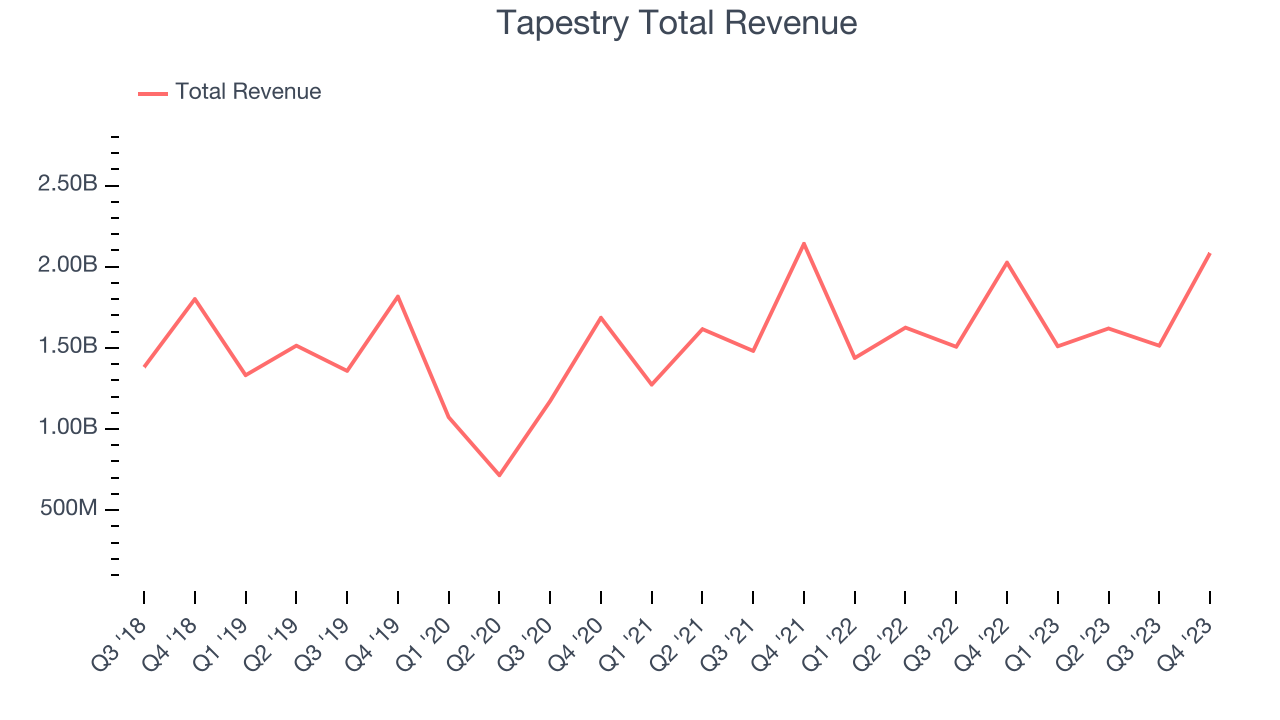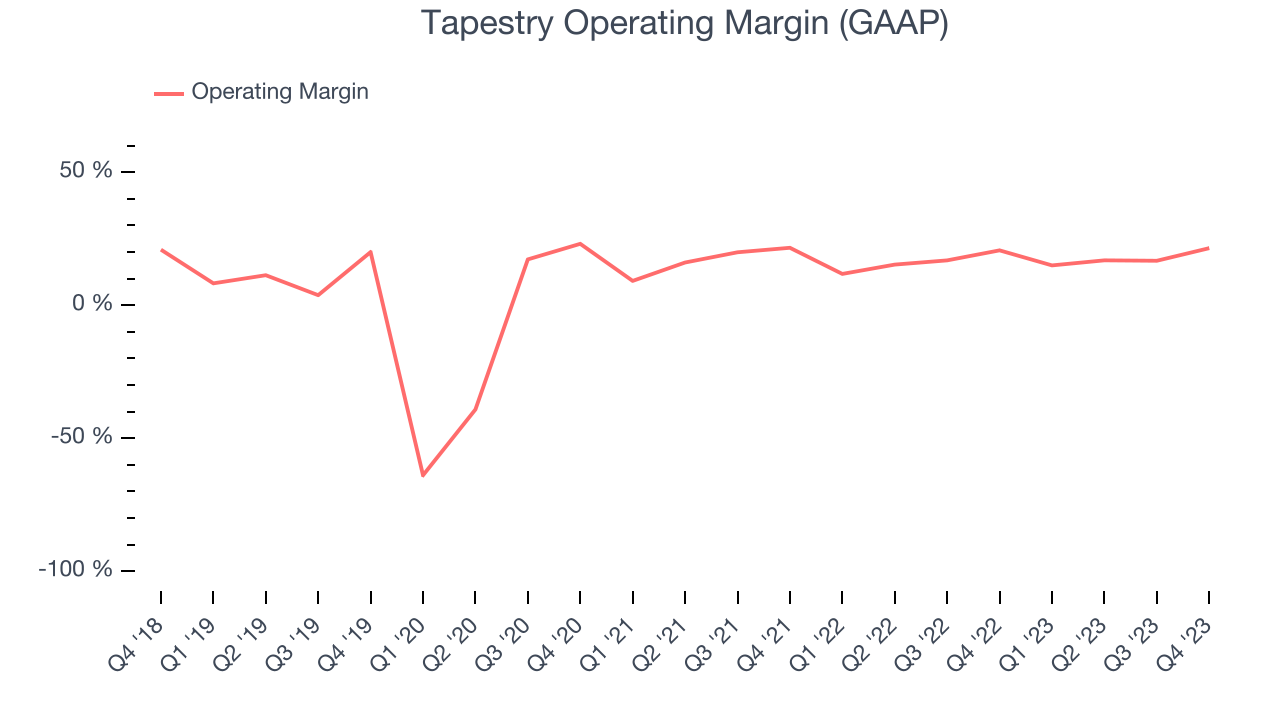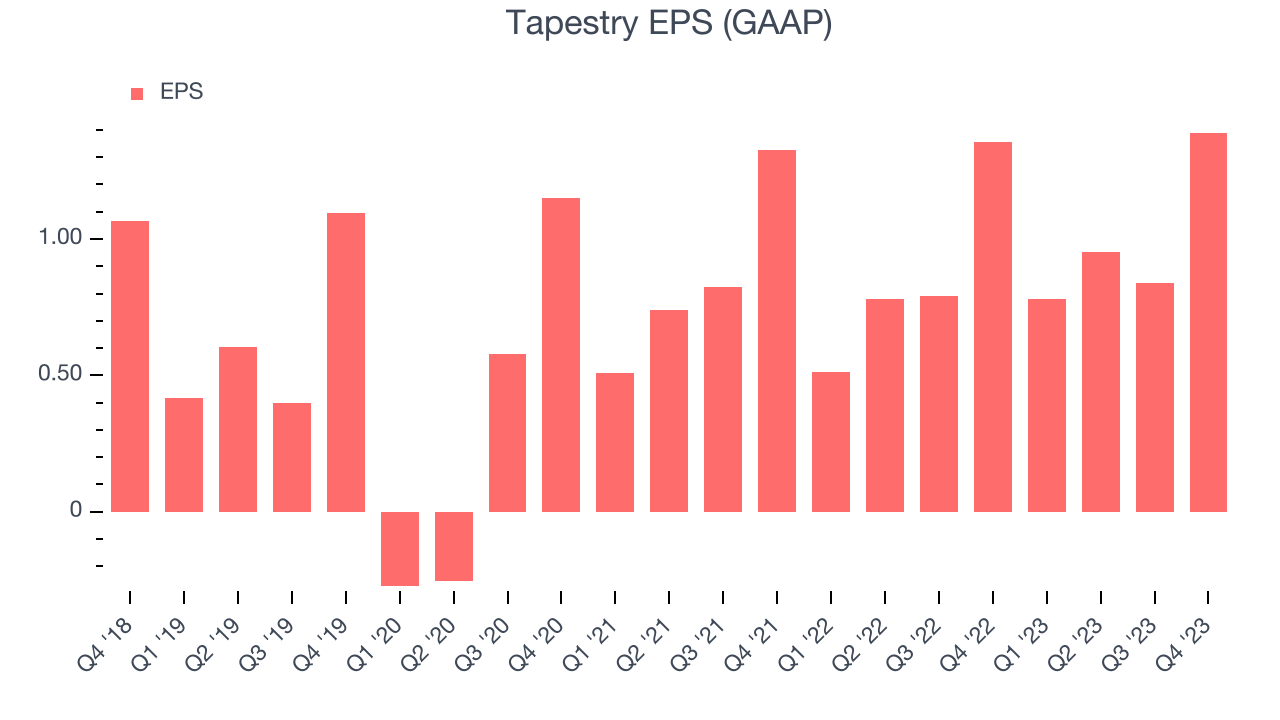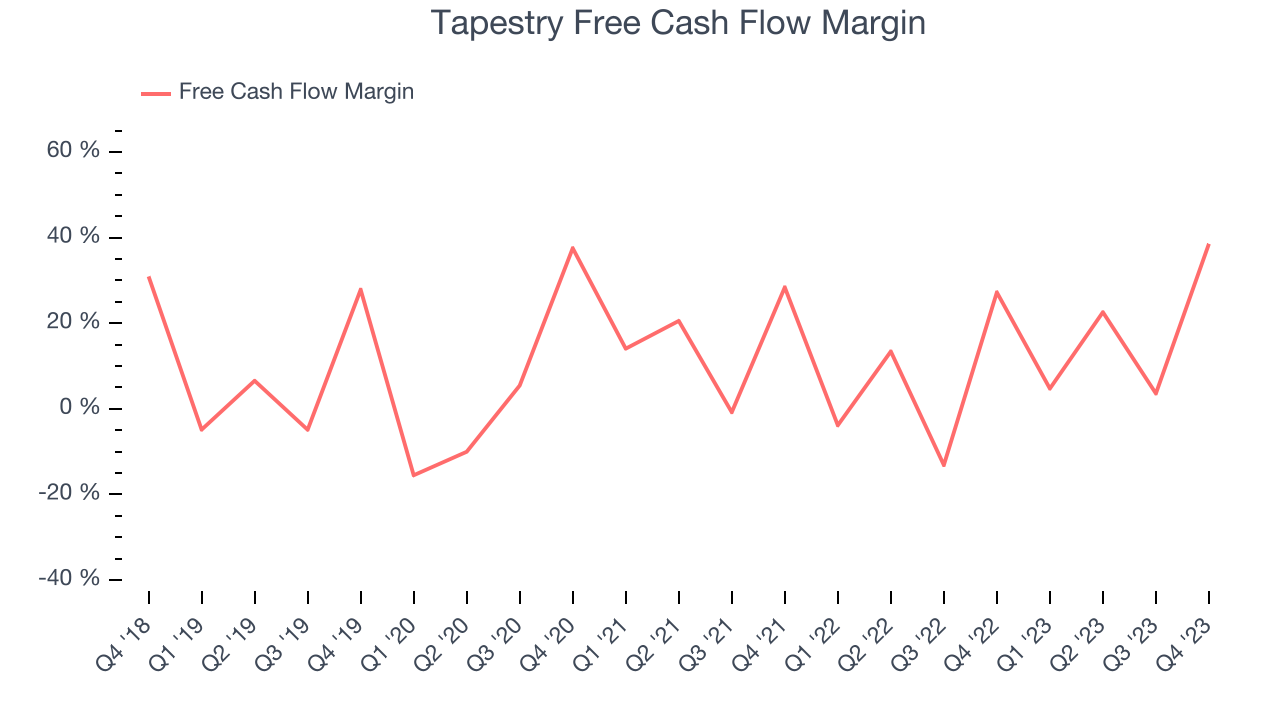Luxury fashion conglomerate Tapestry (NYSE:TPR) announced better-than-expected results in Q2 FY2024, with revenue up 2.9% year on year to $2.08 billion. The company expects the full year's revenue to be around $6.7 billion, in line with analysts' estimates. It made a GAAP profit of $1.39 per share, improving from its profit of $1.36 per share in the same quarter last year.
Tapestry (TPR) Q2 FY2024 Highlights:
- Revenue: $2.08 billion vs analyst estimates of $2.06 billion (1.4% beat)
- EPS: $1.39 vs analyst expectations of $1.46 (4.5% miss)
- The company reconfirmed its revenue guidance for the full year of $6.7 billion at the midpoint
- The company raised its EPS guidance for the full year to $4..23 at the midpoint (above estimates of $4.12)
- Free Cash Flow of $803.7 million, up from $54.4 million in the previous quarter
- Gross Margin (GAAP): 71.6%, up from 68.6% in the same quarter last year
- Market Capitalization: $9.25 billion
Originally founded as Coach, Tapestry (NYSE:TPR) is an American fashion conglomerate with a portfolio of luxury brands offering high-quality accessories and fashion products.
Coach, the cornerstone brand of the company that was founded in 1941, became a leader in the luxury leather goods market, offering iconic high-quality handbags. With an expanding vision, the company evolved to encompass other notable brands in the luxury market such as Kate Spade New York and Stuart Weitzman.
In 2017, Coach rebranded to Tapestry to better mirror its multi-brand identity. The company allows each brand to retain its uniqueness while leveraging Tapestry's vast resources, creating synergies.
Tapestry grew its portfolio once again in 2023 when it agreed to buy Capri Holdings. The acquisition gave it ownership of Versace, Jimmy Choo, and Michael Kors. These brands also appeal to fashion-savvy and brand-conscious luxury-centric customers with a preference for premium clothing and accessories.
Apparel, Accessories and Luxury Goods
Within apparel and accessories, not only do styles change more frequently today than decades past as fads travel through social media and the internet but consumers are also shifting the way they buy their goods, favoring omnichannel and e-commerce experiences. Some apparel, accessories, and luxury goods companies have made concerted efforts to adapt while those who are slower to move may fall behind.
Tapestry’s main competitors are PVH Corp (NYSE:PVH) who owns Calvin Klein and Tommy Hilfiger; Kering (OTCMKTS:PPRUY) who owns Gucci, Yves Saint Laurent, and Bottega Veneta; LVMH Moët Hennessy Louis Vuitton (OTCMKTS:LVMUY) who owns Louis Vuitton, Dior, Givenchy; Ralph Lauren (NYSE:RL)Sales Growth
Exploring a company's long-term performance can offer valuable insights into its business quality. Any business can experience brief periods of success, but distinguished ones maintain steady growth over time. Tapestry's annualized revenue growth rate of 2.4% over the last 5 years was weak for a consumer discretionary business.

Within consumer discretionary, a long-term historical view may miss a company riding a successful new product or emerging trend. That's why we also follow short-term performance. Tapestry's annualized revenue growth of 1.6% over the last 2 years is in line with its 5-year revenue growth, suggesting the company's demand has been stable. Tapestry also reports sales performance excluding currency movements, which are outside the company’s control and not indicative of demand. Over the last 2 years, its constant currency sales averaged 4.4% year-on-year growth. Because this number is higher than its revenue growth during the same period, we can see that macroeconomic challenges hindered Tapestry's top-line performance.
This quarter, Tapestry reported reasonable year-on-year revenue growth of 2.9%, and its $2.08 billion of revenue topped Wall Street's estimates by 1.4%. Looking ahead, Wall Street expects sales to grow 1.8% over the next 12 months, a deceleration from this quarter.
Operating Margin
Operating margin is an important measure of profitability. It’s the portion of revenue left after accounting for all core expenses–everything from the cost of goods sold to advertising and wages. Operating margin is also useful for comparing profitability across companies with different levels of debt and tax rates because it excludes interest and taxes.
Tapestry has been a well-managed company over the last eight quarters. It's demonstrated it can be one of the more profitable businesses in the consumer discretionary sector, boasting an average operating margin of 16.8%.
In Q2, Tapestry generated an operating profit margin of 21.5%, in line with the same quarter last year. This indicates the company's costs have been relatively stable.
Over the next 12 months, Wall Street expects Tapestry to maintain its LTM operating margin of 17.8%.EPS
Analyzing long-term revenue trends tells us about a company's historical growth, but the long-term change in its earnings per share (EPS) points to the profitability and efficiency of that growth–for example, a company could inflate its sales through excessive spending on advertising and promotions. 
Over the last 5 years, Tapestry's EPS grew 71.7%, translating into a decent 11.4% compounded annual growth rate. This performance is materially higher than its 2.4% annualized revenue growth over the same period. There are a few reasons for this, and understanding why can shed light on its fundamentals.
A 5-year view shows that Tapestry has repurchased its stock, shrinking its share count by 20.4%. This has led to higher PER share earnings. Taxes and interest expenses can also affect EPS growth, but they don't tell us as much about a company's fundamentals.In Q2, Tapestry reported EPS at $1.39, up from $1.36 in the same quarter a year ago. This print unfortunately missed analysts' estimates, but we care more about long-term EPS growth rather than short-term movements. Over the next 12 months, Wall Street expects Tapestry to grow its earnings. Analysts are projecting its LTM EPS of $3.96 to climb by 5% to $4.16.
Cash Is King
Although earnings are undoubtedly valuable for assessing company performance, we believe cash is king because you can't use accounting profits to pay the bills.
Over the last two years, Tapestry has shown decent cash profitability, giving it some reinvestment opportunities. The company's free cash flow margin has averaged 11.6%, slightly better than the broader consumer discretionary sector.

Tapestry's free cash flow came in at $803.7 million in Q2, equivalent to a 38.6% margin, up 45.8% year on year. Over the next year, analysts predict Tapestry's cash profitability will fall. Their consensus estimates imply its LTM free cash flow margin of 19.3% will decrease to 11.1%.
Return on Invested Capital (ROIC)
EPS and free cash flow tell us whether a company was profitable while growing revenue. But was it capital-efficient? Enter ROIC, a metric showing how much operating profit a company generates relative to how much money the business raised (debt and equity).
Tapestry's five-year average return on invested capital was 15.6%, slightly better than the broader sector. Just as you’d like your investment dollars to generate returns, Tapestry's invested capital has produced decent profits.
The trend in its ROIC, however, is often what surprises the market and drives the stock price. Over the last two years, Tapestry's ROIC has generally increased its returns. This is a good sign, and if Tapestry's returns keep rising, there's a chance it could evolve into an investable business.
Key Takeaways from Tapestry's Q2 Results
We enjoyed seeing Tapestry raise its EPS outlook, which beat analysts' expectations. We were also glad its constant currency revenue outperformed Wall Street's estimates. On the other hand, its EPS missed analysts' expectations and its full-year revenue guidance was maintained, slightly missing Wall Street's estimates. Zooming out, we think this was still a decent, albeit mixed, quarter, showing that the company is staying on track. The stock is up 2.6% after reporting and currently trades at $41.41 per share.
Is Now The Time?
Tapestry may have had a favorable quarter, but investors should also consider its valuation and business qualities when assessing the investment opportunity.
We cheer for all companies serving consumers, but in the case of Tapestry, we'll be cheering from the sidelines. Its revenue growth has been weak over the last five years. And while its rising ROIC shows management is finding profitable business opportunities, the downside is its constant currency sales performance has been subpar over the last two years. On top of that, its projected EPS for the next year is lacking.
Tapestry's price-to-earnings ratio based on the next 12 months is 9.5x. While we've no doubt one can find things to like about Tapestry, we think there are better opportunities elsewhere in the market. We don't see many reasons to get involved at the moment.
Wall Street analysts covering the company had a one-year price target of $45.13 per share right before these results (compared to the current share price of $41.41).
To get the best start with StockStory, check out our most recent stock picks, and then sign up for our earnings alerts by adding companies to your watchlist here. We typically have the quarterly earnings results analyzed within seconds of the data being released, and especially for companies reporting pre-market, this often gives investors the chance to react to the results before the market has fully absorbed the information.
